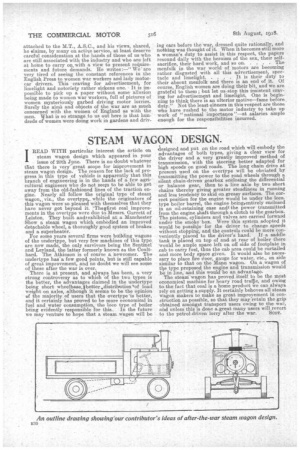STEAM WAGON DESIGN.
Page 10

If you've noticed an error in this article please click here to report it so we can fix it.
I READ WITH particular interest the article on steam wagon design which appeared in your
issue of 20th June. There is no doubt whatever that there is very'great scope for improvement in steam wagon design. The reason for the lack of progress in this type of vehicle is apparently that this branch of engineering is in the hands of a few agritultural engineers who do net seem to be able to get away from the old-fashioned lines of the traction engine. Nearly all follow the original type of steam wagon„ viz., the overtype, while the originators of this wagon were so pleased with themselves that they have never got beyond it. "Thetfirst real improvements in the overtype were due to Messrs. Garrett of Leiston. They built and/ exhibited at a Manchester Show a steam wagon which embodied an improved detachable wheel, a thoroughly good system of brakes and a superheater.
For some years several firms were building wagons of the undertype, but very few machines of this type are now made, the only survivors being the Sentinel and Leyland, the latter formerly known as the Coulthard. The Atkinson is of course a newcomer. The undertype has a few good points, but is still capable of great improvement, and no doubt we will see some of these after the war is over.
There is at present, and always has been, a very strong controversy as to which of the two types is the better, the advantages claimed in the undertype being short wheelbase,lbetter *distribution'4of load weight on axles, although it seems to be the opinion a the majority of users that the overtype is better, and it certainly has proved to be more economical in fuel and water consumption, the loco type of boiler being evidently responsible for this. In the future we may venture to hope that a steam wagen will be elesigned and put on the road which will embody the advantages of both types, giving a, clear view for the driver and a very greatly improved method of transmission, with the steering better adapted for high speeds on good roads. 'The long chain drive at present used on the overtype will be obviated by transmitting the power to the road wheels through a silent chain-driven gearbox enclosing the differential or balance gear, then to a live axle by two short chains thereby giving greater steadiness in running and less tendency to skid on greasy surfaces. The correct position for the engine would be under the loco. type boiler barrel, the engine beingontirely enclosed in an oil-retaining case and( the power transmitted from the engine shaft through a clutch to the gearbox. The pistons; cylinders and valves are carried forward under the smoke box. Were this system adopted it would be possible for the driver to change speeds without stopping, and the controls could be more conveniently placed to the driver's hand. If a saddle tank is placed on top of and at rear of boiler there 'would be .ample space left on off side of footplate in cab to carry fuel, thus the cab area could be curtailed and more body space given. It would also be necessary to place fire door, gauge for water, etc., on side similar to that on the Mann wagon. On a wagon of the type proposed the engine and transmission would be in line, and this wouldbe an advantage. .
The steam wagon has proved, itself to be the most economical machine for heavy road trafpc, and owing to the fact that coal is a home product we can always rely on getting a supply. It certainly behoves all steam wagon makers to make as great improyement in construction as possible, so that they may retain the grip obtained amongst transport users owing to the war, and unless this is done agreat many users will revert to the petrol-driven' lorry after the war. SCOT.






















